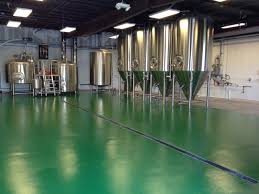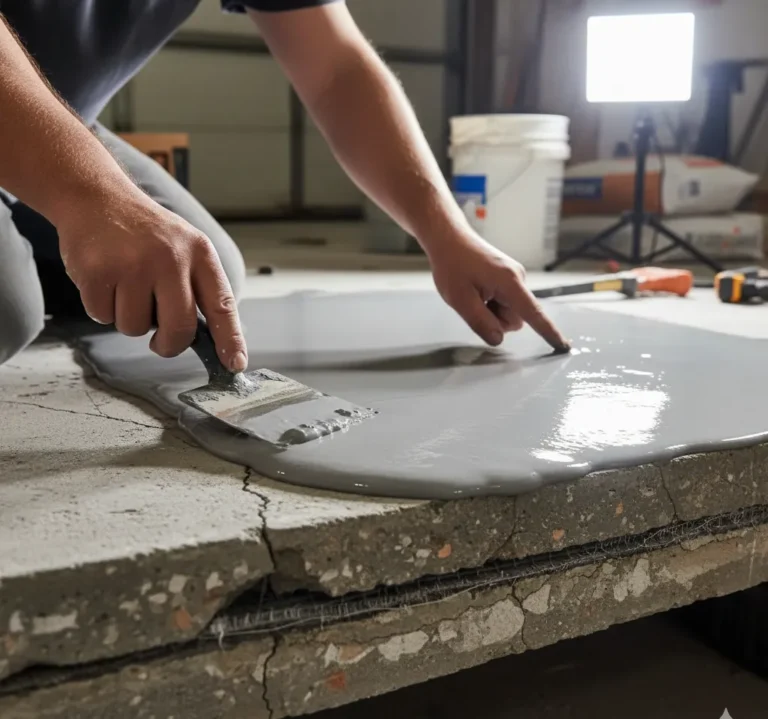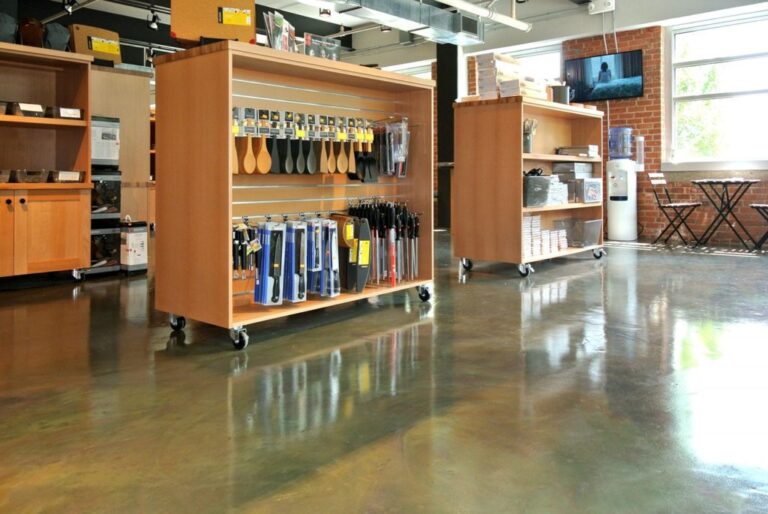What Are the Disadvantages of Microcement?
Microcement has gained popularity as a versatile flooring and wall coating option in recent years. However, like any material, it comes with its own set of drawbacks. In this comprehensive guide, we’ll explore the disadvantages of microcement, helping you make an informed decision for your next renovation project.
Common Microcement Problems
Fissures and Cracks in Microcement
One of the most significant issues with microcement is its susceptibility to fissures and cracks. These imperfections can occur due to various factors, including substrate movement, improper application, or extreme temperature changes.
Microcement is a thin layer applied over existing surfaces, making it vulnerable to any underlying structural issues. If the base surface is not properly prepared or has existing cracks, these problems can easily transfer to the microcement layer.
Causes of fissures and cracks:
- Substrate movement
- Improper application
- Extreme temperature fluctuations
- Inadequate surface preparation
Appearance of Defects
Another disadvantage of microcement is the potential for visible defects in the finished surface. These imperfections can range from minor blemishes to more noticeable flaws that detract from the overall aesthetic appeal.
Common defects include:
- Pinholes
- Color inconsistencies
- Uneven texture
- Visible trowel marks
These issues often result from improper mixing, application techniques, or curing conditions. Even small mistakes during the installation process can lead to noticeable defects in the final product.
Poor Condition of the Support
The quality of the underlying support surface plays a crucial role in the success of a microcement application. If the support is in poor condition, it can lead to various problems with the microcement layer.
Issues with the support surface may include:
- Uneven surfaces
- Existing cracks or damage
- Moisture problems
- Inadequate structural integrity
Addressing these issues before applying microcement is essential, but it can significantly increase the overall cost and complexity of the project.
| Support Surface Issue | Potential Impact on Microcement |
| Uneven surfaces | Visible imperfections, cracking |
| Existing cracks | Crack transfer to microcement |
| Moisture problems | Delamination, discoloration |
| Poor structural integrity | Cracking, separation |
Making Mistakes in the Application of Microcement
Incorrect Repair of a Microcement Surface
Repairing microcement surfaces can be challenging, and incorrect repair techniques can lead to further damage or unsightly results. Unlike traditional flooring materials, microcement repairs often require specialized knowledge and skills.
Common repair mistakes include:
- Using incompatible materials
- Improper surface preparation
- Failing to match the original color and texture
- Inadequate curing time for repairs
These errors can result in visible patches or areas that stand out from the surrounding surface, compromising the seamless appearance that microcement is known for.
Underestimating Negative Dampness Before Placing Microcement
Moisture issues can be a significant problem when applying microcement. Failing to properly assess and address dampness in the underlying surface can lead to severe complications.
Consequences of underestimating dampness include:
- Delamination of the microcement layer
- Discoloration and staining
- Mold and mildew growth
- Reduced durability and longevity
According to Duraamen, a leading manufacturer of concrete coatings, proper moisture testing and mitigation are crucial steps in ensuring a successful microcement application.
Sealing the Microcement with an Inappropriate Varnish
Choosing the right sealer is essential for protecting microcement surfaces and maintaining their appearance. Using an inappropriate varnish can lead to various issues:
- Yellowing or discoloration over time
- Inadequate protection against stains and moisture
- Peeling or flaking of the sealer
- Difficulty in cleaning and maintenance
It’s crucial to select a high-quality sealer specifically designed for use with microcement to ensure optimal performance and longevity.
Durability Concerns 
Does Microcement Crack Easily?
While microcement is generally durable, it can be prone to cracking under certain conditions. Factors that contribute to cracking include:
- Substrate movement
- Improper installation techniques
- Excessive weight or impact
- Extreme temperature fluctuations
To minimize the risk of cracking, proper surface preparation, expert application, and the use of high-quality materials are essential.
Longevity Issues
The longevity of microcement surfaces can be a concern for some property owners. While well-maintained microcement can last for many years, it may not have the same lifespan as some traditional flooring materials.
Factors affecting microcement longevity:
- Quality of installation
- Level of foot traffic and use
- Maintenance practices
- Environmental conditions
Regular maintenance and proper care are crucial for extending the life of microcement surfaces and preserving their appearance.
| Factor | Impact on Longevity |
| Installation quality | High impact |
| Foot traffic | Moderate to high impact |
| Maintenance | High impact |
| Environmental conditions | Moderate impact |
Maintenance Challenges
Cleaning and Upkeep
Maintaining microcement surfaces requires regular care and attention. While generally easy to clean, there are some challenges to consider:
- Sensitivity to harsh cleaning chemicals
- Potential for staining if not sealed properly
- Need for regular resealing to maintain protection
- Difficulty in removing stubborn stains without damaging the surface
Proper cleaning techniques and products are essential to preserve the appearance and integrity of microcement surfaces.
Repair and Restoration
Repairing and restoring damaged microcement surfaces can be challenging and often requires professional expertise. Unlike some flooring materials that can be easily replaced in sections, microcement repairs may involve addressing larger areas to maintain a seamless appearance.
Challenges in repair and restoration include:
- Matching the original color and texture
- Ensuring proper adhesion of new material to existing surfaces
- Addressing underlying issues that caused the damage
- Potential need for extensive surface preparation
These factors can make repairs more time-consuming and costly compared to some alternative flooring options.
Cost and Affordability
Initial Investment
The initial cost of installing microcement can be higher than some traditional flooring options. Factors contributing to the cost include:
- Specialized materials and equipment
- Expert labor for proper application
- Extensive surface preparation requirements
- Need for high-quality sealers and finishes
While the seamless, modern appearance of microcement is appealing, the upfront investment may be a disadvantage for budget-conscious consumers.
Long-Term Costs
When considering the long-term costs of microcement, it’s important to factor in ongoing maintenance and potential repair expenses. While microcement can be durable, it may require more frequent maintenance and care compared to some alternative flooring materials.
Long-term cost considerations:
- Regular resealing to maintain protection
- Professional cleaning and maintenance services
- Potential for costly repairs if damage occurs
- Possible need for complete replacement in high-traffic areas
These ongoing expenses should be weighed against the initial investment when evaluating the overall cost-effectiveness of microcement.
Environmental and Health Considerations 
Eco Impact
While microcement is often touted as an eco-friendly option due to its low material usage, there are some environmental concerns to consider:
- Use of chemical sealers and finishes
- Potential for VOC emissions during application and curing
- Limited recyclability at the end of its lifecycle
- Energy-intensive production process for some microcement components
Consumers concerned about environmental impact should carefully research the specific products and application methods used in their microcement project.
Safety Concerns
During the application process, there are some safety considerations to keep in mind:
- Dust generation during surface preparation
- Potential exposure to chemical fumes from sealers and finishes
- Slip hazards if not properly textured or sealed
- Risk of allergic reactions in sensitive individuals
Proper safety precautions and ventilation are essential during installation to minimize these risks.
Is Microcement Easy to DIY?
Expert Application Techniques
While some DIY enthusiasts may be tempted to tackle microcement installation themselves, it’s important to understand the complexity of the process. Expert application techniques are crucial for achieving a high-quality, durable finish.
Key aspects of expert application include:
- Proper surface preparation and priming
- Precise mixing of microcement components
- Skilled trowel techniques for smooth application
- Careful control of curing conditions
These techniques require practice and experience to master, making professional installation a safer choice for most projects.
Common DIY Mistakes
Attempting a DIY microcement installation can lead to various mistakes that compromise the quality and durability of the finish. Common errors include:
- Inadequate surface preparation
- Incorrect mixing ratios
- Uneven application thickness
- Improper curing techniques
- Insufficient sealing and protection
These mistakes can result in a subpar finish that may require costly professional intervention to correct. Flooring options microcement is a thin layer of cement that can be applied over existing floors to create a smooth and modern look It comes in various colors and can be used in both indoor and outdoor spaces Microcement transforms interiors by giving walls and floors a smooth modern look It can make old spaces feel brand new without needing major renovations
Decorative microcement options Microcement tiles longevity Microcement tiles can last for many years if properly maintained and cared for They are durable and resistant to wear making them a long-lasting option for flooring and wall coverings Dubai cultural spaces microcement is a special material used to make floors and walls look smooth in places where people learn about Dubai’s culture It helps create a modern look while still respecting the traditional feel of these important spaces
Microcement enhances boutiques by giving stores a sleek modern look Its smooth surface and customizable colors create a stylish shopping environment Sleek gallery surfaces make art displays look smooth and modern They help paintings and sculptures stand out in museums and art shows
Minimalist microcement walls create a smooth and sleek look in homes They are perfect for modern spaces that want a clean and simple style Sleek microcement surfaces are smooth and modern-looking floors or walls They are made by applying thin layers of special cement to create a seamless and stylish finish
Microcement vs. Other Flooring Options
Microcement vs. Tiles: Durability and Longevity
When comparing microcement to tiles, there are several factors to consider in terms of durability and longevity:
- Microcement: Seamless surface, but potentially more prone to cracking
- Tiles: Individual pieces that can be replaced if damaged, but grout lines may deteriorate
While both options can be durable, tiles may have an advantage in high-traffic areas due to their ability to be selectively replaced.
Microcement vs. Tiles: Cost and Affordability
Cost considerations between microcement and tiles include:
- Microcement: Higher initial cost, potential for ongoing maintenance expenses
- Tiles: Variable cost depending on material, lower long-term maintenance costs
The choice between the two often depends on budget constraints and long-term cost projections.
Microcement vs. Tiles: Maintenance
Maintenance requirements differ between microcement and tiles:
- Microcement: Regular sealing, careful cleaning to avoid damage
- Tiles: Grout cleaning, potential for individual tile replacement
While microcement offers a seamless surface that can be easier to clean, tiles may be more forgiving in terms of long-term maintenance and repair.
| Factor | Microcement | Tiles |
| Durability | Moderate to high | High |
| Cost | Higher initial cost | Variable, potentially lower |
| Maintenance | Regular sealing required | Grout maintenance needed |
| Repair | Challenging | Easier (individual tile replacement) |
FAQs
What are the disadvantages of microcement in terms of durability?
Microcement can be prone to cracking and fissures, especially if not properly installed or if there are issues with the underlying surface. It may also be more susceptible to damage from heavy impacts or extreme temperature changes compared to some traditional flooring materials. Regular maintenance and proper sealing are essential to ensure long-term durability.
How does microcement compare to other flooring options in terms of cost?
Microcement typically has a higher initial cost compared to many traditional flooring options due to the specialized materials and expert labor required for installation. However, its seamless appearance and potential for application over existing surfaces can offset some costs. Long-term expenses, including regular maintenance and potential repairs, should also be considered when comparing overall costs to other flooring options.
What are the common problems faced during the application of microcement?
Common issues during microcement application include uneven surfaces, color inconsistencies, and visible trowel marks. Proper surface preparation, expert application techniques, and careful control of curing conditions are crucial to avoid these problems. Additionally, addressing any underlying moisture issues or structural problems in the support surface is essential for a successful microcement installation.
Is microcement a good choice for DIY projects?
Microcement installation is generally not recommended as a DIY project due to the specialized skills and knowledge required for proper application. The process involves precise mixing ratios, expert trowel techniques, and careful control of curing conditions. Attempting a DIY installation can lead to various issues, including uneven surfaces, poor adhesion, and inadequate protection. For best results, it’s advisable to hire experienced professionals for microcement application.
What maintenance challenges are associated with microcement?
Maintaining microcement surfaces requires regular care and attention. Challenges include sensitivity to harsh cleaning chemicals, the need for periodic resealing to maintain protection, and potential difficulty in removing stubborn stains without damaging the surface. Additionally, repairing damaged areas can be complex and may require professional intervention to maintain a seamless appearance. Proper cleaning techniques and the use of appropriate products are essential for preserving the integrity and appearance of microcement surfaces.





